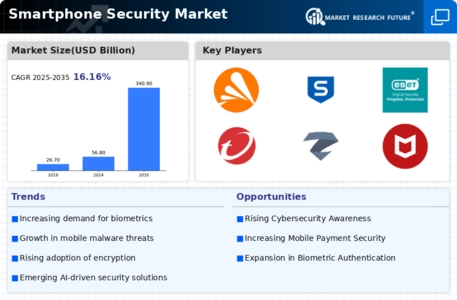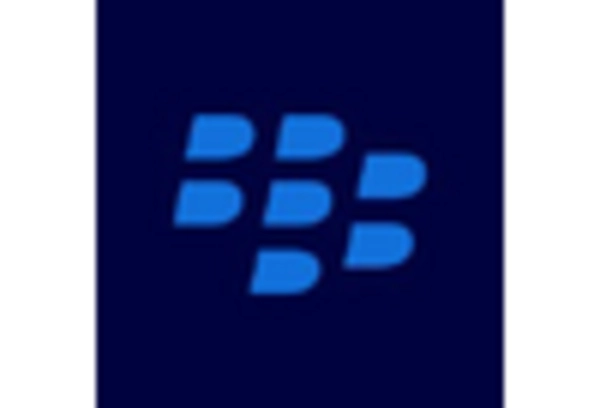Increasing Cybersecurity Threats
The Smartphone Security Market is experiencing heightened demand due to the increasing frequency and sophistication of cyber threats. As mobile devices become integral to daily life, they also attract malicious actors seeking to exploit vulnerabilities. Reports indicate that mobile malware attacks have surged, with a significant rise in phishing attempts targeting smartphone users. This trend compels consumers and businesses alike to invest in robust security solutions, thereby driving growth in the Smartphone Security Market. The need for comprehensive security measures, including antivirus software and secure browsing tools, is more pressing than ever, as users seek to protect sensitive information from unauthorized access.
Rising Awareness of Data Privacy
The Smartphone Security Market is benefiting from a growing awareness among consumers regarding data privacy issues. As high-profile data breaches and privacy scandals come to light, users are becoming increasingly vigilant about their personal information. This heightened awareness drives demand for security solutions that prioritize user privacy, such as end-to-end encryption and secure messaging applications. Consumers are actively seeking products that offer transparency and control over their data, prompting companies to innovate and enhance their security offerings. This shift in consumer behavior is likely to shape the future of the Smartphone Security Market, as businesses adapt to meet the evolving expectations of privacy-conscious users.
Regulatory Compliance Requirements
The Smartphone Security Market is significantly influenced by evolving regulatory frameworks aimed at enhancing data protection and privacy. Governments across various regions are implementing stringent regulations that mandate businesses to adopt specific security measures to safeguard user data. For instance, regulations such as the General Data Protection Regulation (GDPR) have set high standards for data handling practices. Companies that fail to comply face substantial penalties, which incentivizes them to invest in advanced security solutions. This regulatory landscape not only drives demand for smartphone security products but also fosters innovation within the Smartphone Security Market as firms strive to meet compliance standards.
Advancements in Security Technologies
The Smartphone Security Market is propelled by rapid advancements in security technologies, which are continuously evolving to counter emerging threats. Innovations such as artificial intelligence and machine learning are being integrated into security solutions, enabling real-time threat detection and response. These technologies enhance the effectiveness of security measures, making them more appealing to consumers and businesses alike. As the landscape of cyber threats becomes increasingly complex, the demand for sophisticated security solutions is expected to rise. This trend indicates a promising future for the Smartphone Security Market, as companies invest in cutting-edge technologies to stay ahead of potential vulnerabilities.
Growing Adoption of Mobile Payment Solutions
The Smartphone Security Market is witnessing a surge in demand driven by the increasing adoption of mobile payment solutions. As consumers increasingly rely on smartphones for financial transactions, the need for secure payment systems becomes paramount. Data suggests that mobile payment transactions are projected to reach trillions of dollars in the coming years, highlighting the critical importance of security in this domain. Consequently, businesses are compelled to implement advanced security measures, such as encryption and tokenization, to protect sensitive financial information. This trend not only enhances consumer confidence but also propels growth within the Smartphone Security Market as security solutions become essential for mobile payment providers.

















Leave a Comment